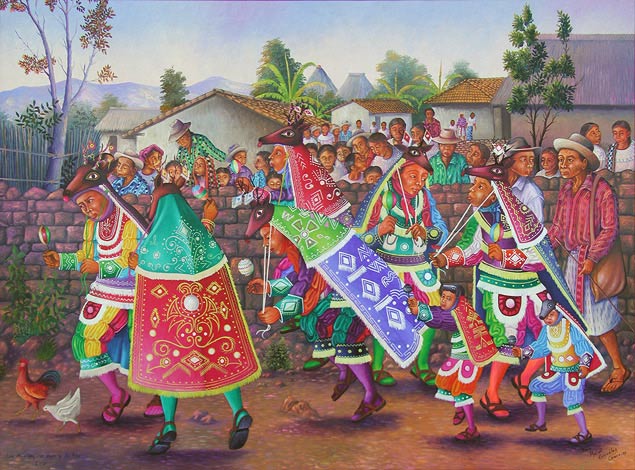 |
|
| Pedro Rafael González Chavajay Las Huellas de Ayer y de Hoy Footsteps of Yesterday and Today Left panel 2001 30" x 40" |
|
| The left panel of the triptych, Las Huellas de Ayer y de Hoy, is of the masked dance, a Maya tradition that predates the Spanish Conquest. This particular masked dance is the Baile de Venado, or Deer Dance, which is among the oldest of the dances. Thomas Gage gives us the earliest known description of such a dance (1648:225-226): | |
|
|
| The Maya most probably performed the original deer dance before a hunt to insure success and the safe return of the hunters. Even before the Conquest the Maya dances had a dance master who choreographed the dances and taught the dancers their dialogue. The words of the dance remained the Tz'utujil Mayan language rather than Spanish so while the outward form had to conform to the restrictions of Catholic priests the words could still convey old traditions. The tradition of having a dance master continues today with the dancers practicing the dances months before the performances. The masks and costumes are rented from a moreria an establishment peculiar to Guatemala which only exists in a few towns. It is usually run by a family of talented mask-makers and passed down from generation to generation. When they are ready to perform the dance, the dance master and some of the dancers go to rent the costumes from the moreria. Before there were highways, this meant a walk of about two days to the town of Totonicapan, the nearest moreria to San Pedro la Laguna. Because of the effort and expense the masked dances usually are only performed during the festival of the town's patron saint especially in the smaller towns. Before the arrival of television these dances were the highlight of the year. Over time the morerias created ever more brilliant and flashy costumes as dancers and spectators preferred these. What would have been animal skins worn by the hunters have now became the elaborate capes of the Spaniards. While the cofradias still existed, the masked dances were performed at the cofradia houses. The dances were an integral part of the religious rituals and the processions. After the cofradias disappeared the dances too were threatened, but there seems to be a resurgence of interest in Maya traditions by the people, so for the time being they are still being performed. However, the dances now have no direct connection to the Catholic Church. They are more like a traveling theater troupe which stops in the street to give a performance. The masked dance is now performed separately and the effect is similar to exhibiting this one canvas alone without the two other panels. |